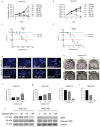In Silico Target Identification of Galangin, as an Herbal Flavonoid against Cholangiocarcinoma
- PMID: 35889537
- PMCID: PMC9351686
- DOI: 10.3390/molecules27144664
In Silico Target Identification of Galangin, as an Herbal Flavonoid against Cholangiocarcinoma
Abstract
Cholangiocarcinoma (CCA) is a heterogenous group of malignancies in the bile duct, which proliferates aggressively. CCA is highly prevalent in Northeastern Thailand wherein it is associated with liver fluke infection, or Opisthorchis viverrini (OV). Most patients are diagnosed in advanced stages, when the cancer has metastasized or severely progressed, thereby limiting treatment options. Several studies investigate the effect of traditional Thai medicinal plants that may be potential therapeutic options in combating CCA. Galangin is one such herbal flavonoid that has medicinal properties and exhibits anti-tumor properties in various cancers. In this study, we investigate the role of Galangin in inhibiting cell proliferation, invasion, and migration in OV-infected CCA cell lines. We discovered that Galangin reduced cell viability and colony formation by inducing apoptosis in CCA cell lines in a dose-dependent manner. Further, Galangin also effectively inhibited invasion and migration in OV-infected CCA cells by reduction of MMP2 and MMP9 enzymatic activity. Additionally, using proteomics, we identified proteins affected post-treatment with Galangin. Enrichment analysis revealed that several kinase pathways were affected by Galangin, and the signature corroborated with that of small molecule kinase inhibitors. Hence, we identified putative targets of Galangin using an in silico approach which highlighted c-Met as candidate target. Galangin effectively inhibited c-Met phosphorylation and subsequent signaling in in vitro CCA cells. In addition, Galangin was able to inhibit HGF, a mediator of c-Met signaling, by suppressing HGF-stimulated invasion, as well as migration and MMP9 activity. This shows that Galangin can be a useful anti-metastatic therapeutic strategy in a subtype of CCA patients.
Keywords: Galangin; anti-cancer; cholangiocarcinoma; molecular docking; proteomics.
Conflict of interest statement
The authors declare no conflict of interest.
Figures







References
-
- Pairojkul C. Liver fluke and cholangiocarcinoma in Thailand. Pathology. 2014;46:S24. doi: 10.1097/01.PAT.0000454133.12330.87. - DOI
-
- Leelawat K., Leelawat S., Tepaksorn P., Rattanasinganchan P., Leungchaweng A., Tohtong R., Sobhon P. Involvement of c-Met/hepatocyte growth factor pathway in cholangiocarcinoma cell invasion and its therapeutic inhibition with small interfering RNA specific for c-Met. J. Surg. Res. 2006;136:78–84. doi: 10.1016/j.jss.2006.05.031. - DOI - PubMed
MeSH terms
Substances
Grants and funding
LinkOut - more resources
Full Text Sources
Medical
Miscellaneous

